Financial Strategy: GDF Suez Capital Structure and Financing
VerifiedAdded on 2020/02/03
|9
|2684
|57
Report
AI Summary
This report provides a detailed financial analysis of GDF Suez, focusing on its capital structure and short-term financing strategies. The report begins with an appraisal of GDF Suez's capital structure, examining its debt-to-equity ratio and the implications of changes in this ratio over time. It then critically evaluates the theoretical advantages and disadvantages of GDF Suez's capital structure, considering factors such as the cost of capital, tax implications, and the impact on managerial decision-making. The second part of the report explores GDF Suez's short-term financing perspective, including an examination of working capital management and the use of various financing options. Finally, the report offers a critical evaluation of the potential advantages and disadvantages of GDF Suez's financial strategy, assessing the firm's approach to managing financial risk and optimizing its capital structure.
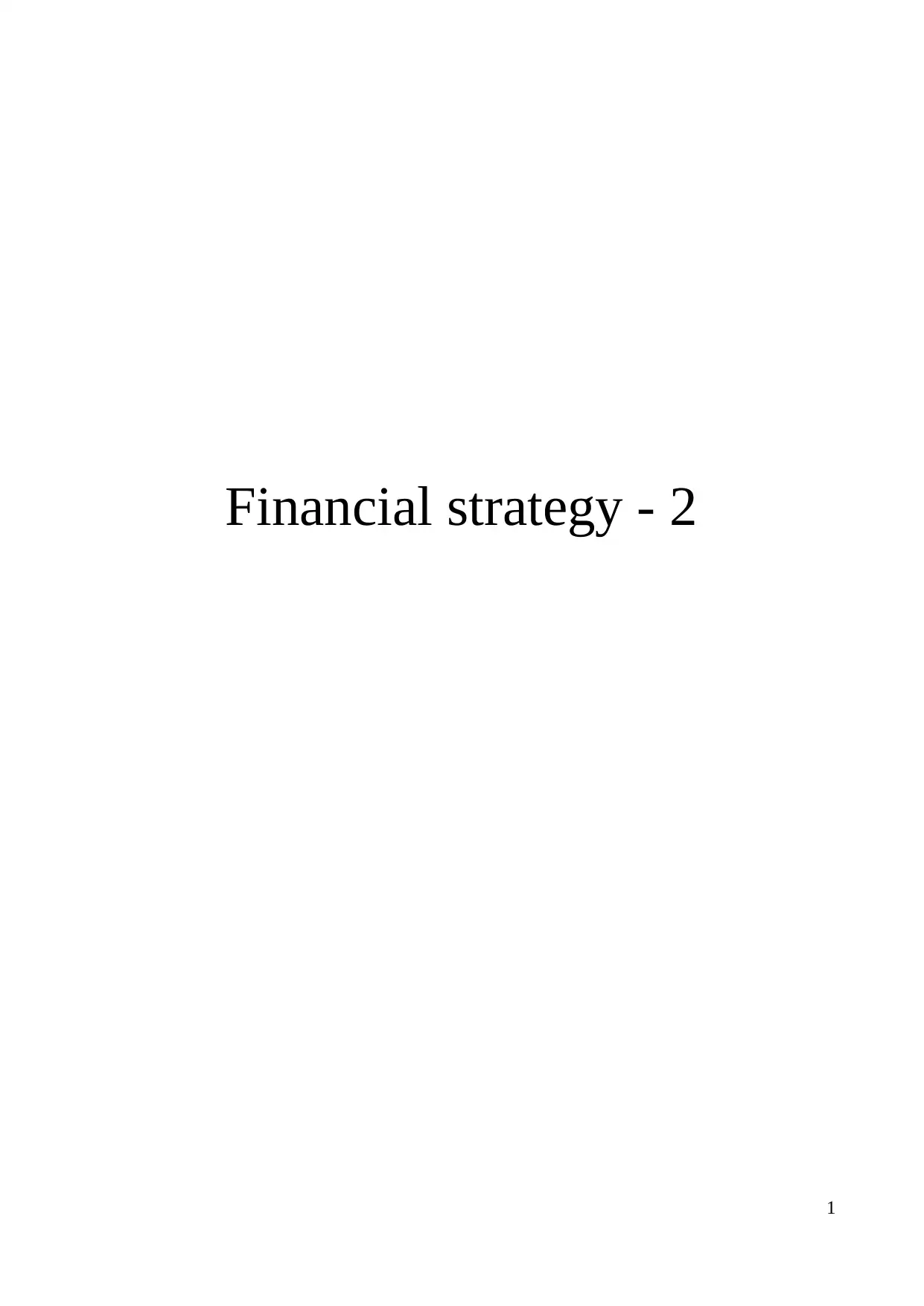
Financial strategy - 2
1
1
Paraphrase This Document
Need a fresh take? Get an instant paraphrase of this document with our AI Paraphraser
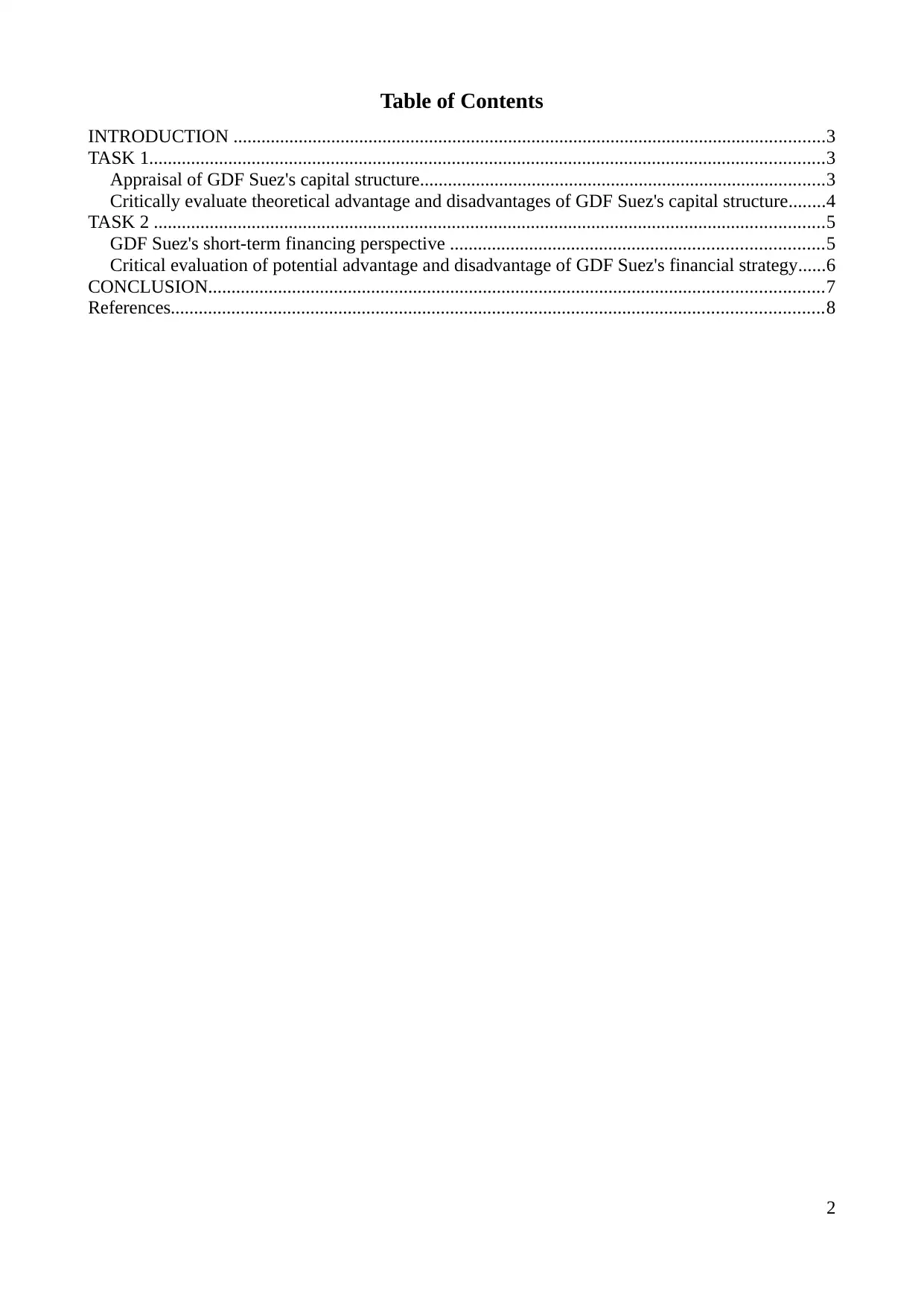
Table of Contents
INTRODUCTION ...............................................................................................................................3
TASK 1.................................................................................................................................................3
Appraisal of GDF Suez's capital structure.......................................................................................3
Critically evaluate theoretical advantage and disadvantages of GDF Suez's capital structure........4
TASK 2 ................................................................................................................................................5
GDF Suez's short-term financing perspective ................................................................................5
Critical evaluation of potential advantage and disadvantage of GDF Suez's financial strategy......6
CONCLUSION....................................................................................................................................7
References............................................................................................................................................8
2
INTRODUCTION ...............................................................................................................................3
TASK 1.................................................................................................................................................3
Appraisal of GDF Suez's capital structure.......................................................................................3
Critically evaluate theoretical advantage and disadvantages of GDF Suez's capital structure........4
TASK 2 ................................................................................................................................................5
GDF Suez's short-term financing perspective ................................................................................5
Critical evaluation of potential advantage and disadvantage of GDF Suez's financial strategy......6
CONCLUSION....................................................................................................................................7
References............................................................................................................................................8
2
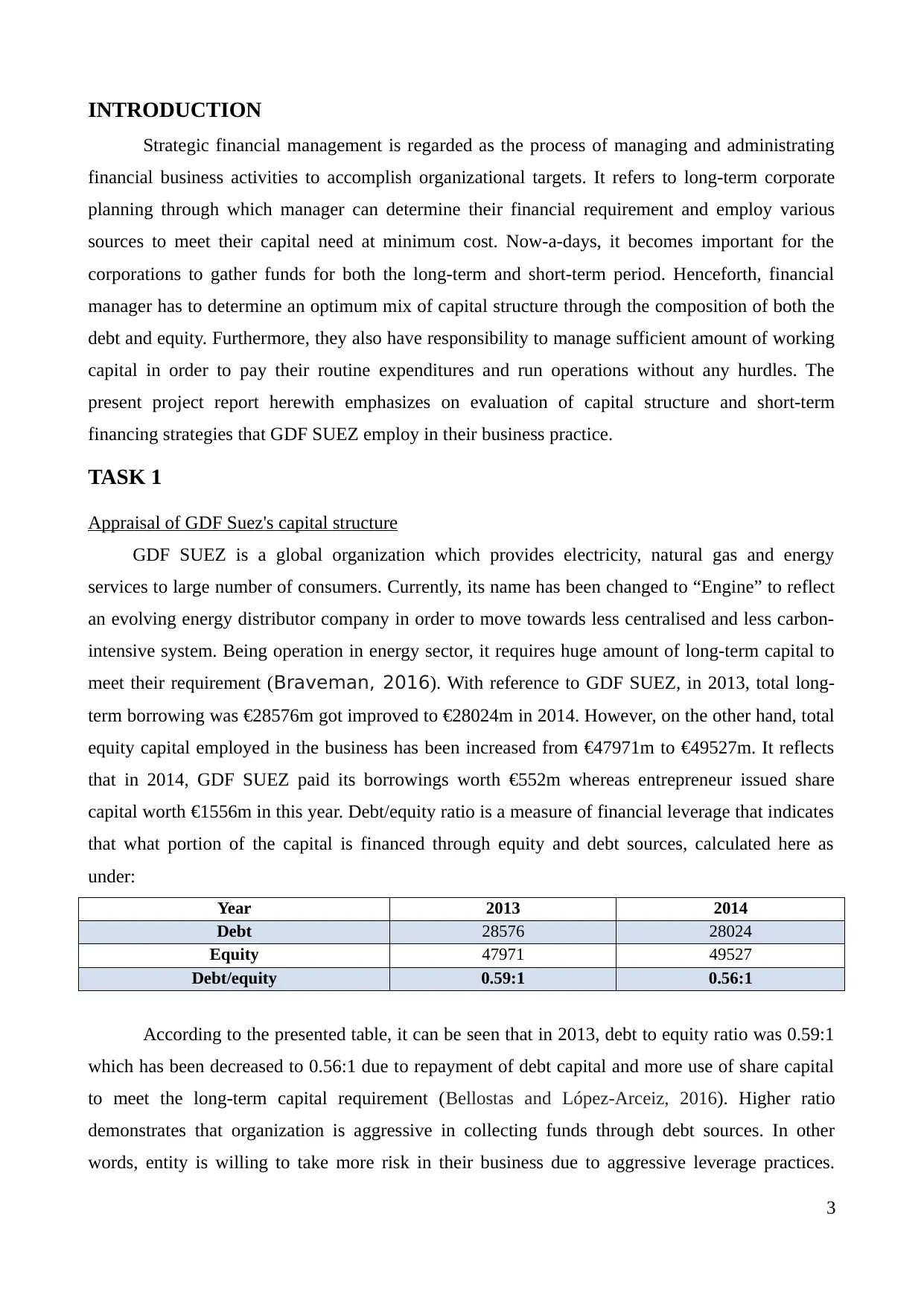
INTRODUCTION
Strategic financial management is regarded as the process of managing and administrating
financial business activities to accomplish organizational targets. It refers to long-term corporate
planning through which manager can determine their financial requirement and employ various
sources to meet their capital need at minimum cost. Now-a-days, it becomes important for the
corporations to gather funds for both the long-term and short-term period. Henceforth, financial
manager has to determine an optimum mix of capital structure through the composition of both the
debt and equity. Furthermore, they also have responsibility to manage sufficient amount of working
capital in order to pay their routine expenditures and run operations without any hurdles. The
present project report herewith emphasizes on evaluation of capital structure and short-term
financing strategies that GDF SUEZ employ in their business practice.
TASK 1
Appraisal of GDF Suez's capital structure
GDF SUEZ is a global organization which provides electricity, natural gas and energy
services to large number of consumers. Currently, its name has been changed to “Engine” to reflect
an evolving energy distributor company in order to move towards less centralised and less carbon-
intensive system. Being operation in energy sector, it requires huge amount of long-term capital to
meet their requirement (Braveman, 2016). With reference to GDF SUEZ, in 2013, total long-
term borrowing was €28576m got improved to €28024m in 2014. However, on the other hand, total
equity capital employed in the business has been increased from €47971m to €49527m. It reflects
that in 2014, GDF SUEZ paid its borrowings worth €552m whereas entrepreneur issued share
capital worth €1556m in this year. Debt/equity ratio is a measure of financial leverage that indicates
that what portion of the capital is financed through equity and debt sources, calculated here as
under:
Year 2013 2014
Debt 28576 28024
Equity 47971 49527
Debt/equity 0.59:1 0.56:1
According to the presented table, it can be seen that in 2013, debt to equity ratio was 0.59:1
which has been decreased to 0.56:1 due to repayment of debt capital and more use of share capital
to meet the long-term capital requirement (Bellostas and López-Arceiz, 2016). Higher ratio
demonstrates that organization is aggressive in collecting funds through debt sources. In other
words, entity is willing to take more risk in their business due to aggressive leverage practices.
3
Strategic financial management is regarded as the process of managing and administrating
financial business activities to accomplish organizational targets. It refers to long-term corporate
planning through which manager can determine their financial requirement and employ various
sources to meet their capital need at minimum cost. Now-a-days, it becomes important for the
corporations to gather funds for both the long-term and short-term period. Henceforth, financial
manager has to determine an optimum mix of capital structure through the composition of both the
debt and equity. Furthermore, they also have responsibility to manage sufficient amount of working
capital in order to pay their routine expenditures and run operations without any hurdles. The
present project report herewith emphasizes on evaluation of capital structure and short-term
financing strategies that GDF SUEZ employ in their business practice.
TASK 1
Appraisal of GDF Suez's capital structure
GDF SUEZ is a global organization which provides electricity, natural gas and energy
services to large number of consumers. Currently, its name has been changed to “Engine” to reflect
an evolving energy distributor company in order to move towards less centralised and less carbon-
intensive system. Being operation in energy sector, it requires huge amount of long-term capital to
meet their requirement (Braveman, 2016). With reference to GDF SUEZ, in 2013, total long-
term borrowing was €28576m got improved to €28024m in 2014. However, on the other hand, total
equity capital employed in the business has been increased from €47971m to €49527m. It reflects
that in 2014, GDF SUEZ paid its borrowings worth €552m whereas entrepreneur issued share
capital worth €1556m in this year. Debt/equity ratio is a measure of financial leverage that indicates
that what portion of the capital is financed through equity and debt sources, calculated here as
under:
Year 2013 2014
Debt 28576 28024
Equity 47971 49527
Debt/equity 0.59:1 0.56:1
According to the presented table, it can be seen that in 2013, debt to equity ratio was 0.59:1
which has been decreased to 0.56:1 due to repayment of debt capital and more use of share capital
to meet the long-term capital requirement (Bellostas and López-Arceiz, 2016). Higher ratio
demonstrates that organization is aggressive in collecting funds through debt sources. In other
words, entity is willing to take more risk in their business due to aggressive leverage practices.
3
⊘ This is a preview!⊘
Do you want full access?
Subscribe today to unlock all pages.

Trusted by 1+ million students worldwide
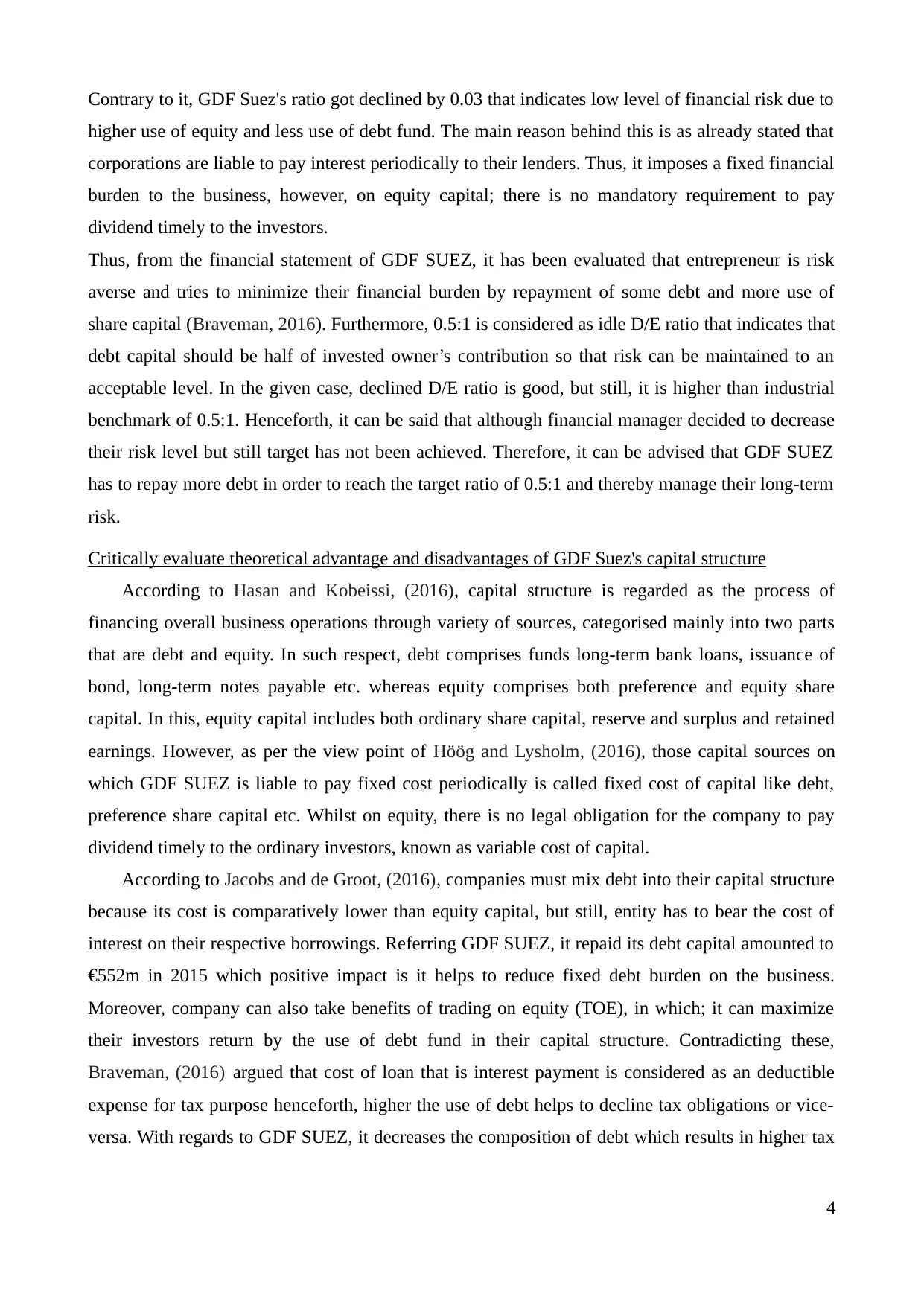
Contrary to it, GDF Suez's ratio got declined by 0.03 that indicates low level of financial risk due to
higher use of equity and less use of debt fund. The main reason behind this is as already stated that
corporations are liable to pay interest periodically to their lenders. Thus, it imposes a fixed financial
burden to the business, however, on equity capital; there is no mandatory requirement to pay
dividend timely to the investors.
Thus, from the financial statement of GDF SUEZ, it has been evaluated that entrepreneur is risk
averse and tries to minimize their financial burden by repayment of some debt and more use of
share capital (Braveman, 2016). Furthermore, 0.5:1 is considered as idle D/E ratio that indicates that
debt capital should be half of invested owner’s contribution so that risk can be maintained to an
acceptable level. In the given case, declined D/E ratio is good, but still, it is higher than industrial
benchmark of 0.5:1. Henceforth, it can be said that although financial manager decided to decrease
their risk level but still target has not been achieved. Therefore, it can be advised that GDF SUEZ
has to repay more debt in order to reach the target ratio of 0.5:1 and thereby manage their long-term
risk.
Critically evaluate theoretical advantage and disadvantages of GDF Suez's capital structure
According to Hasan and Kobeissi, (2016), capital structure is regarded as the process of
financing overall business operations through variety of sources, categorised mainly into two parts
that are debt and equity. In such respect, debt comprises funds long-term bank loans, issuance of
bond, long-term notes payable etc. whereas equity comprises both preference and equity share
capital. In this, equity capital includes both ordinary share capital, reserve and surplus and retained
earnings. However, as per the view point of Höög and Lysholm, (2016), those capital sources on
which GDF SUEZ is liable to pay fixed cost periodically is called fixed cost of capital like debt,
preference share capital etc. Whilst on equity, there is no legal obligation for the company to pay
dividend timely to the ordinary investors, known as variable cost of capital.
According to Jacobs and de Groot, (2016), companies must mix debt into their capital structure
because its cost is comparatively lower than equity capital, but still, entity has to bear the cost of
interest on their respective borrowings. Referring GDF SUEZ, it repaid its debt capital amounted to
€552m in 2015 which positive impact is it helps to reduce fixed debt burden on the business.
Moreover, company can also take benefits of trading on equity (TOE), in which; it can maximize
their investors return by the use of debt fund in their capital structure. Contradicting these,
Braveman, (2016) argued that cost of loan that is interest payment is considered as an deductible
expense for tax purpose henceforth, higher the use of debt helps to decline tax obligations or vice-
versa. With regards to GDF SUEZ, it decreases the composition of debt which results in higher tax
4
higher use of equity and less use of debt fund. The main reason behind this is as already stated that
corporations are liable to pay interest periodically to their lenders. Thus, it imposes a fixed financial
burden to the business, however, on equity capital; there is no mandatory requirement to pay
dividend timely to the investors.
Thus, from the financial statement of GDF SUEZ, it has been evaluated that entrepreneur is risk
averse and tries to minimize their financial burden by repayment of some debt and more use of
share capital (Braveman, 2016). Furthermore, 0.5:1 is considered as idle D/E ratio that indicates that
debt capital should be half of invested owner’s contribution so that risk can be maintained to an
acceptable level. In the given case, declined D/E ratio is good, but still, it is higher than industrial
benchmark of 0.5:1. Henceforth, it can be said that although financial manager decided to decrease
their risk level but still target has not been achieved. Therefore, it can be advised that GDF SUEZ
has to repay more debt in order to reach the target ratio of 0.5:1 and thereby manage their long-term
risk.
Critically evaluate theoretical advantage and disadvantages of GDF Suez's capital structure
According to Hasan and Kobeissi, (2016), capital structure is regarded as the process of
financing overall business operations through variety of sources, categorised mainly into two parts
that are debt and equity. In such respect, debt comprises funds long-term bank loans, issuance of
bond, long-term notes payable etc. whereas equity comprises both preference and equity share
capital. In this, equity capital includes both ordinary share capital, reserve and surplus and retained
earnings. However, as per the view point of Höög and Lysholm, (2016), those capital sources on
which GDF SUEZ is liable to pay fixed cost periodically is called fixed cost of capital like debt,
preference share capital etc. Whilst on equity, there is no legal obligation for the company to pay
dividend timely to the ordinary investors, known as variable cost of capital.
According to Jacobs and de Groot, (2016), companies must mix debt into their capital structure
because its cost is comparatively lower than equity capital, but still, entity has to bear the cost of
interest on their respective borrowings. Referring GDF SUEZ, it repaid its debt capital amounted to
€552m in 2015 which positive impact is it helps to reduce fixed debt burden on the business.
Moreover, company can also take benefits of trading on equity (TOE), in which; it can maximize
their investors return by the use of debt fund in their capital structure. Contradicting these,
Braveman, (2016) argued that cost of loan that is interest payment is considered as an deductible
expense for tax purpose henceforth, higher the use of debt helps to decline tax obligations or vice-
versa. With regards to GDF SUEZ, it decreases the composition of debt which results in higher tax
4
Paraphrase This Document
Need a fresh take? Get an instant paraphrase of this document with our AI Paraphraser
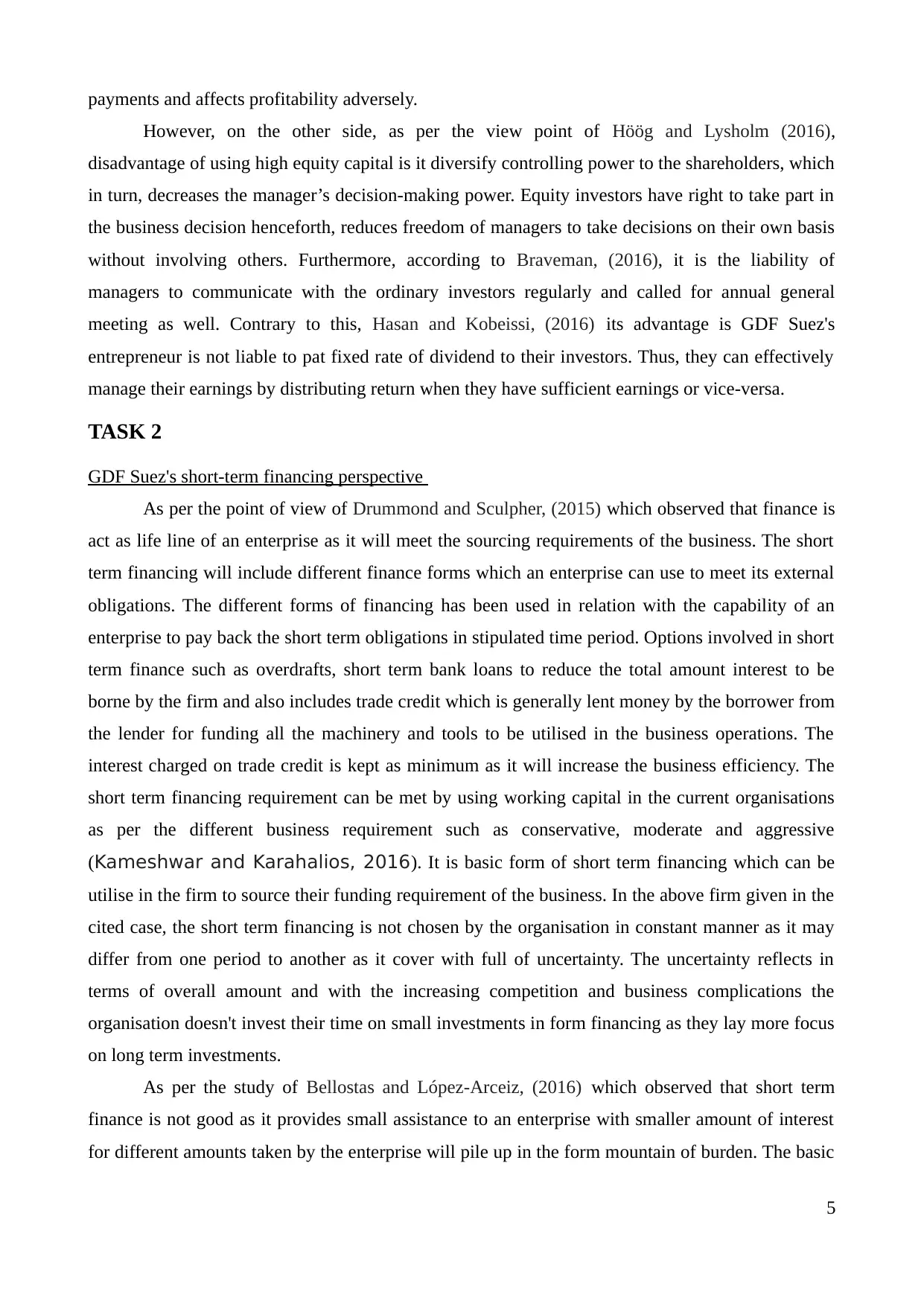
payments and affects profitability adversely.
However, on the other side, as per the view point of Höög and Lysholm (2016),
disadvantage of using high equity capital is it diversify controlling power to the shareholders, which
in turn, decreases the manager’s decision-making power. Equity investors have right to take part in
the business decision henceforth, reduces freedom of managers to take decisions on their own basis
without involving others. Furthermore, according to Braveman, (2016), it is the liability of
managers to communicate with the ordinary investors regularly and called for annual general
meeting as well. Contrary to this, Hasan and Kobeissi, (2016) its advantage is GDF Suez's
entrepreneur is not liable to pat fixed rate of dividend to their investors. Thus, they can effectively
manage their earnings by distributing return when they have sufficient earnings or vice-versa.
TASK 2
GDF Suez's short-term financing perspective
As per the point of view of Drummond and Sculpher, (2015) which observed that finance is
act as life line of an enterprise as it will meet the sourcing requirements of the business. The short
term financing will include different finance forms which an enterprise can use to meet its external
obligations. The different forms of financing has been used in relation with the capability of an
enterprise to pay back the short term obligations in stipulated time period. Options involved in short
term finance such as overdrafts, short term bank loans to reduce the total amount interest to be
borne by the firm and also includes trade credit which is generally lent money by the borrower from
the lender for funding all the machinery and tools to be utilised in the business operations. The
interest charged on trade credit is kept as minimum as it will increase the business efficiency. The
short term financing requirement can be met by using working capital in the current organisations
as per the different business requirement such as conservative, moderate and aggressive
(Kameshwar and Karahalios, 2016). It is basic form of short term financing which can be
utilise in the firm to source their funding requirement of the business. In the above firm given in the
cited case, the short term financing is not chosen by the organisation in constant manner as it may
differ from one period to another as it cover with full of uncertainty. The uncertainty reflects in
terms of overall amount and with the increasing competition and business complications the
organisation doesn't invest their time on small investments in form financing as they lay more focus
on long term investments.
As per the study of Bellostas and López-Arceiz, (2016) which observed that short term
finance is not good as it provides small assistance to an enterprise with smaller amount of interest
for different amounts taken by the enterprise will pile up in the form mountain of burden. The basic
5
However, on the other side, as per the view point of Höög and Lysholm (2016),
disadvantage of using high equity capital is it diversify controlling power to the shareholders, which
in turn, decreases the manager’s decision-making power. Equity investors have right to take part in
the business decision henceforth, reduces freedom of managers to take decisions on their own basis
without involving others. Furthermore, according to Braveman, (2016), it is the liability of
managers to communicate with the ordinary investors regularly and called for annual general
meeting as well. Contrary to this, Hasan and Kobeissi, (2016) its advantage is GDF Suez's
entrepreneur is not liable to pat fixed rate of dividend to their investors. Thus, they can effectively
manage their earnings by distributing return when they have sufficient earnings or vice-versa.
TASK 2
GDF Suez's short-term financing perspective
As per the point of view of Drummond and Sculpher, (2015) which observed that finance is
act as life line of an enterprise as it will meet the sourcing requirements of the business. The short
term financing will include different finance forms which an enterprise can use to meet its external
obligations. The different forms of financing has been used in relation with the capability of an
enterprise to pay back the short term obligations in stipulated time period. Options involved in short
term finance such as overdrafts, short term bank loans to reduce the total amount interest to be
borne by the firm and also includes trade credit which is generally lent money by the borrower from
the lender for funding all the machinery and tools to be utilised in the business operations. The
interest charged on trade credit is kept as minimum as it will increase the business efficiency. The
short term financing requirement can be met by using working capital in the current organisations
as per the different business requirement such as conservative, moderate and aggressive
(Kameshwar and Karahalios, 2016). It is basic form of short term financing which can be
utilise in the firm to source their funding requirement of the business. In the above firm given in the
cited case, the short term financing is not chosen by the organisation in constant manner as it may
differ from one period to another as it cover with full of uncertainty. The uncertainty reflects in
terms of overall amount and with the increasing competition and business complications the
organisation doesn't invest their time on small investments in form financing as they lay more focus
on long term investments.
As per the study of Bellostas and López-Arceiz, (2016) which observed that short term
finance is not good as it provides small assistance to an enterprise with smaller amount of interest
for different amounts taken by the enterprise will pile up in the form mountain of burden. The basic
5
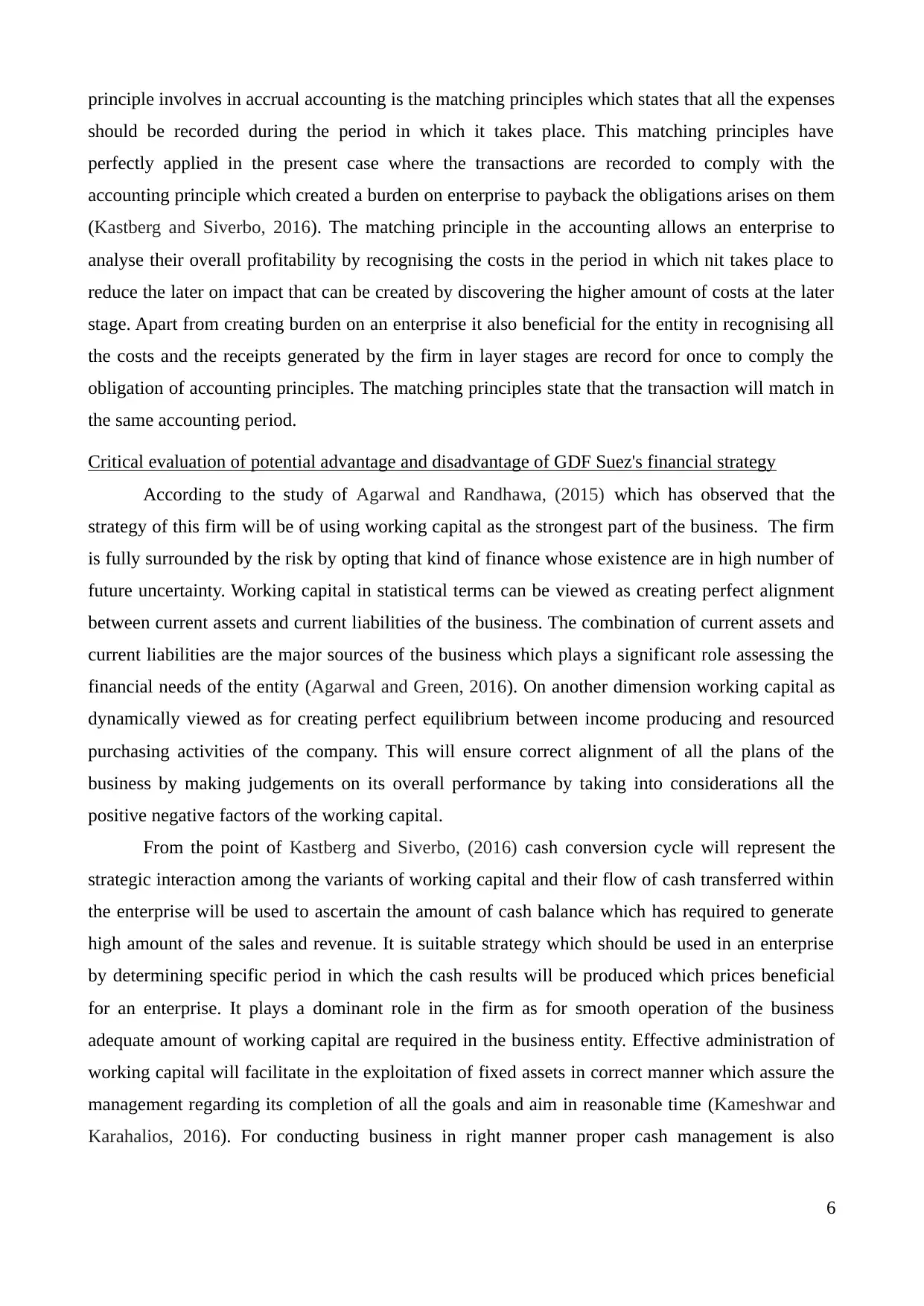
principle involves in accrual accounting is the matching principles which states that all the expenses
should be recorded during the period in which it takes place. This matching principles have
perfectly applied in the present case where the transactions are recorded to comply with the
accounting principle which created a burden on enterprise to payback the obligations arises on them
(Kastberg and Siverbo, 2016). The matching principle in the accounting allows an enterprise to
analyse their overall profitability by recognising the costs in the period in which nit takes place to
reduce the later on impact that can be created by discovering the higher amount of costs at the later
stage. Apart from creating burden on an enterprise it also beneficial for the entity in recognising all
the costs and the receipts generated by the firm in layer stages are record for once to comply the
obligation of accounting principles. The matching principles state that the transaction will match in
the same accounting period.
Critical evaluation of potential advantage and disadvantage of GDF Suez's financial strategy
According to the study of Agarwal and Randhawa, (2015) which has observed that the
strategy of this firm will be of using working capital as the strongest part of the business. The firm
is fully surrounded by the risk by opting that kind of finance whose existence are in high number of
future uncertainty. Working capital in statistical terms can be viewed as creating perfect alignment
between current assets and current liabilities of the business. The combination of current assets and
current liabilities are the major sources of the business which plays a significant role assessing the
financial needs of the entity (Agarwal and Green, 2016). On another dimension working capital as
dynamically viewed as for creating perfect equilibrium between income producing and resourced
purchasing activities of the company. This will ensure correct alignment of all the plans of the
business by making judgements on its overall performance by taking into considerations all the
positive negative factors of the working capital.
From the point of Kastberg and Siverbo, (2016) cash conversion cycle will represent the
strategic interaction among the variants of working capital and their flow of cash transferred within
the enterprise will be used to ascertain the amount of cash balance which has required to generate
high amount of the sales and revenue. It is suitable strategy which should be used in an enterprise
by determining specific period in which the cash results will be produced which prices beneficial
for an enterprise. It plays a dominant role in the firm as for smooth operation of the business
adequate amount of working capital are required in the business entity. Effective administration of
working capital will facilitate in the exploitation of fixed assets in correct manner which assure the
management regarding its completion of all the goals and aim in reasonable time (Kameshwar and
Karahalios, 2016). For conducting business in right manner proper cash management is also
6
should be recorded during the period in which it takes place. This matching principles have
perfectly applied in the present case where the transactions are recorded to comply with the
accounting principle which created a burden on enterprise to payback the obligations arises on them
(Kastberg and Siverbo, 2016). The matching principle in the accounting allows an enterprise to
analyse their overall profitability by recognising the costs in the period in which nit takes place to
reduce the later on impact that can be created by discovering the higher amount of costs at the later
stage. Apart from creating burden on an enterprise it also beneficial for the entity in recognising all
the costs and the receipts generated by the firm in layer stages are record for once to comply the
obligation of accounting principles. The matching principles state that the transaction will match in
the same accounting period.
Critical evaluation of potential advantage and disadvantage of GDF Suez's financial strategy
According to the study of Agarwal and Randhawa, (2015) which has observed that the
strategy of this firm will be of using working capital as the strongest part of the business. The firm
is fully surrounded by the risk by opting that kind of finance whose existence are in high number of
future uncertainty. Working capital in statistical terms can be viewed as creating perfect alignment
between current assets and current liabilities of the business. The combination of current assets and
current liabilities are the major sources of the business which plays a significant role assessing the
financial needs of the entity (Agarwal and Green, 2016). On another dimension working capital as
dynamically viewed as for creating perfect equilibrium between income producing and resourced
purchasing activities of the company. This will ensure correct alignment of all the plans of the
business by making judgements on its overall performance by taking into considerations all the
positive negative factors of the working capital.
From the point of Kastberg and Siverbo, (2016) cash conversion cycle will represent the
strategic interaction among the variants of working capital and their flow of cash transferred within
the enterprise will be used to ascertain the amount of cash balance which has required to generate
high amount of the sales and revenue. It is suitable strategy which should be used in an enterprise
by determining specific period in which the cash results will be produced which prices beneficial
for an enterprise. It plays a dominant role in the firm as for smooth operation of the business
adequate amount of working capital are required in the business entity. Effective administration of
working capital will facilitate in the exploitation of fixed assets in correct manner which assure the
management regarding its completion of all the goals and aim in reasonable time (Kameshwar and
Karahalios, 2016). For conducting business in right manner proper cash management is also
6
⊘ This is a preview!⊘
Do you want full access?
Subscribe today to unlock all pages.

Trusted by 1+ million students worldwide
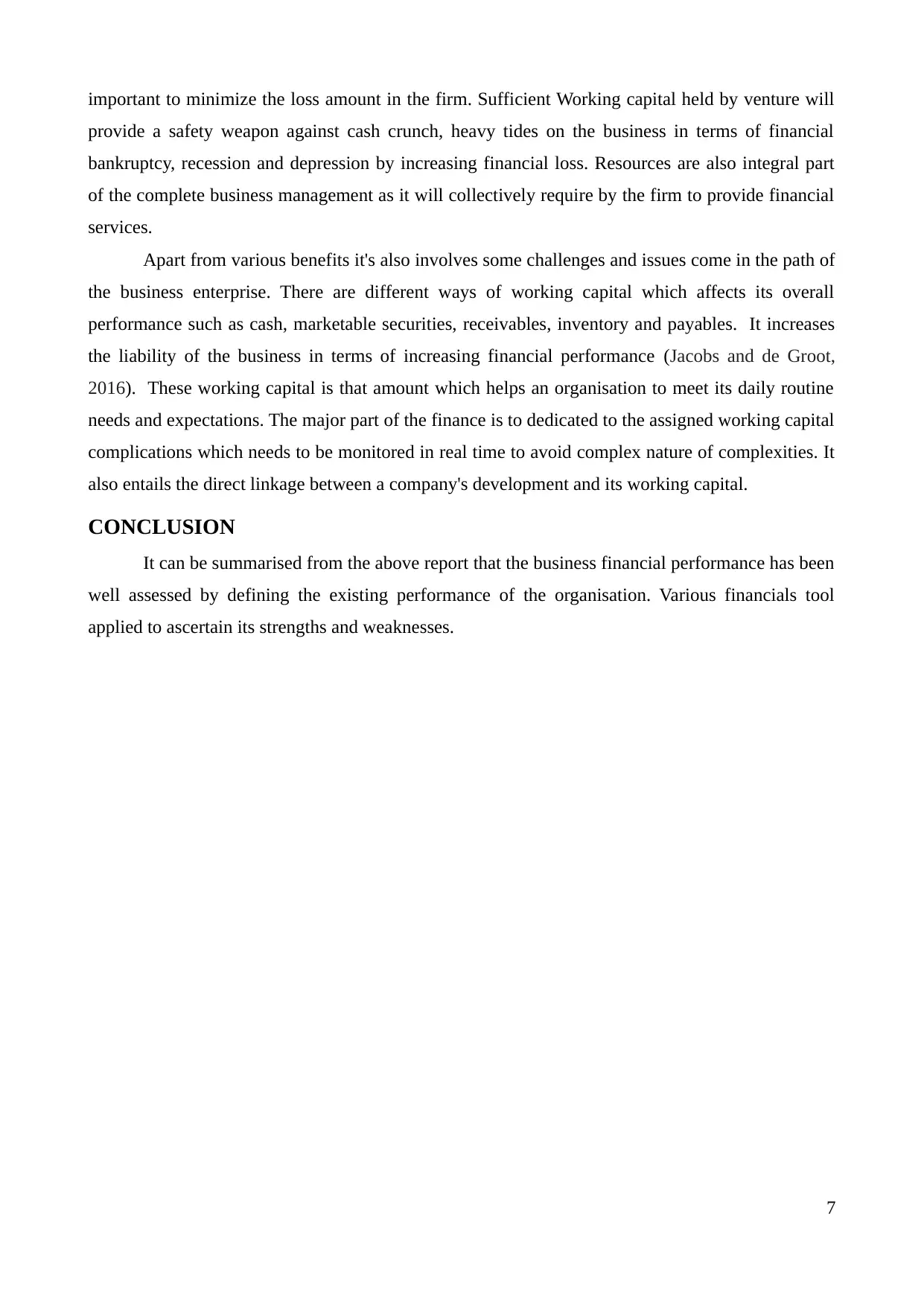
important to minimize the loss amount in the firm. Sufficient Working capital held by venture will
provide a safety weapon against cash crunch, heavy tides on the business in terms of financial
bankruptcy, recession and depression by increasing financial loss. Resources are also integral part
of the complete business management as it will collectively require by the firm to provide financial
services.
Apart from various benefits it's also involves some challenges and issues come in the path of
the business enterprise. There are different ways of working capital which affects its overall
performance such as cash, marketable securities, receivables, inventory and payables. It increases
the liability of the business in terms of increasing financial performance (Jacobs and de Groot,
2016). These working capital is that amount which helps an organisation to meet its daily routine
needs and expectations. The major part of the finance is to dedicated to the assigned working capital
complications which needs to be monitored in real time to avoid complex nature of complexities. It
also entails the direct linkage between a company's development and its working capital.
CONCLUSION
It can be summarised from the above report that the business financial performance has been
well assessed by defining the existing performance of the organisation. Various financials tool
applied to ascertain its strengths and weaknesses.
7
provide a safety weapon against cash crunch, heavy tides on the business in terms of financial
bankruptcy, recession and depression by increasing financial loss. Resources are also integral part
of the complete business management as it will collectively require by the firm to provide financial
services.
Apart from various benefits it's also involves some challenges and issues come in the path of
the business enterprise. There are different ways of working capital which affects its overall
performance such as cash, marketable securities, receivables, inventory and payables. It increases
the liability of the business in terms of increasing financial performance (Jacobs and de Groot,
2016). These working capital is that amount which helps an organisation to meet its daily routine
needs and expectations. The major part of the finance is to dedicated to the assigned working capital
complications which needs to be monitored in real time to avoid complex nature of complexities. It
also entails the direct linkage between a company's development and its working capital.
CONCLUSION
It can be summarised from the above report that the business financial performance has been
well assessed by defining the existing performance of the organisation. Various financials tool
applied to ascertain its strengths and weaknesses.
7
Paraphrase This Document
Need a fresh take? Get an instant paraphrase of this document with our AI Paraphraser
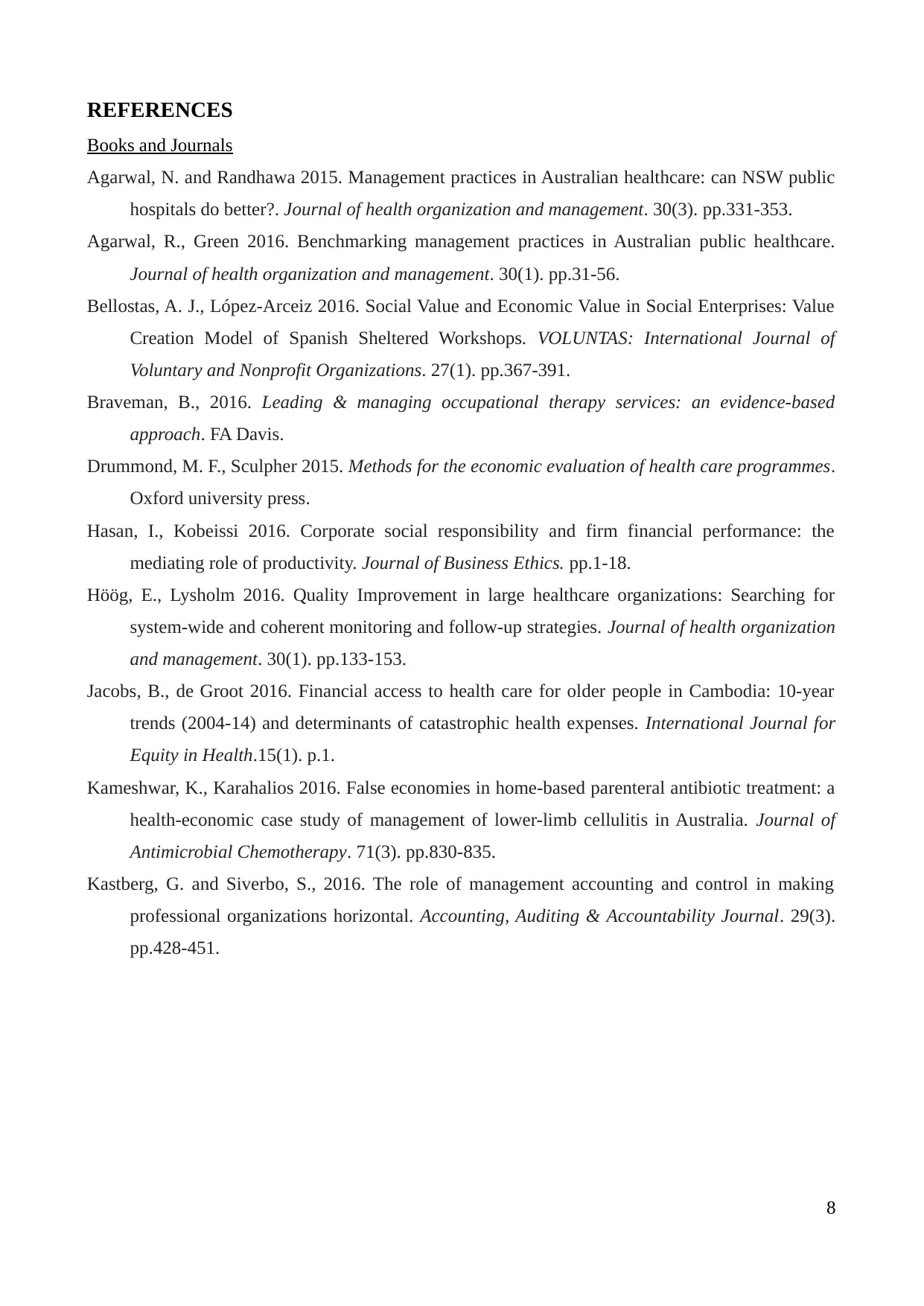
REFERENCES
Books and Journals
Agarwal, N. and Randhawa 2015. Management practices in Australian healthcare: can NSW public
hospitals do better?. Journal of health organization and management. 30(3). pp.331-353.
Agarwal, R., Green 2016. Benchmarking management practices in Australian public healthcare.
Journal of health organization and management. 30(1). pp.31-56.
Bellostas, A. J., López-Arceiz 2016. Social Value and Economic Value in Social Enterprises: Value
Creation Model of Spanish Sheltered Workshops. VOLUNTAS: International Journal of
Voluntary and Nonprofit Organizations. 27(1). pp.367-391.
Braveman, B., 2016. Leading & managing occupational therapy services: an evidence-based
approach. FA Davis.
Drummond, M. F., Sculpher 2015. Methods for the economic evaluation of health care programmes.
Oxford university press.
Hasan, I., Kobeissi 2016. Corporate social responsibility and firm financial performance: the
mediating role of productivity. Journal of Business Ethics. pp.1-18.
Höög, E., Lysholm 2016. Quality Improvement in large healthcare organizations: Searching for
system-wide and coherent monitoring and follow-up strategies. Journal of health organization
and management. 30(1). pp.133-153.
Jacobs, B., de Groot 2016. Financial access to health care for older people in Cambodia: 10-year
trends (2004-14) and determinants of catastrophic health expenses. International Journal for
Equity in Health.15(1). p.1.
Kameshwar, K., Karahalios 2016. False economies in home-based parenteral antibiotic treatment: a
health-economic case study of management of lower-limb cellulitis in Australia. Journal of
Antimicrobial Chemotherapy. 71(3). pp.830-835.
Kastberg, G. and Siverbo, S., 2016. The role of management accounting and control in making
professional organizations horizontal. Accounting, Auditing & Accountability Journal. 29(3).
pp.428-451.
8
Books and Journals
Agarwal, N. and Randhawa 2015. Management practices in Australian healthcare: can NSW public
hospitals do better?. Journal of health organization and management. 30(3). pp.331-353.
Agarwal, R., Green 2016. Benchmarking management practices in Australian public healthcare.
Journal of health organization and management. 30(1). pp.31-56.
Bellostas, A. J., López-Arceiz 2016. Social Value and Economic Value in Social Enterprises: Value
Creation Model of Spanish Sheltered Workshops. VOLUNTAS: International Journal of
Voluntary and Nonprofit Organizations. 27(1). pp.367-391.
Braveman, B., 2016. Leading & managing occupational therapy services: an evidence-based
approach. FA Davis.
Drummond, M. F., Sculpher 2015. Methods for the economic evaluation of health care programmes.
Oxford university press.
Hasan, I., Kobeissi 2016. Corporate social responsibility and firm financial performance: the
mediating role of productivity. Journal of Business Ethics. pp.1-18.
Höög, E., Lysholm 2016. Quality Improvement in large healthcare organizations: Searching for
system-wide and coherent monitoring and follow-up strategies. Journal of health organization
and management. 30(1). pp.133-153.
Jacobs, B., de Groot 2016. Financial access to health care for older people in Cambodia: 10-year
trends (2004-14) and determinants of catastrophic health expenses. International Journal for
Equity in Health.15(1). p.1.
Kameshwar, K., Karahalios 2016. False economies in home-based parenteral antibiotic treatment: a
health-economic case study of management of lower-limb cellulitis in Australia. Journal of
Antimicrobial Chemotherapy. 71(3). pp.830-835.
Kastberg, G. and Siverbo, S., 2016. The role of management accounting and control in making
professional organizations horizontal. Accounting, Auditing & Accountability Journal. 29(3).
pp.428-451.
8

9
⊘ This is a preview!⊘
Do you want full access?
Subscribe today to unlock all pages.

Trusted by 1+ million students worldwide
1 out of 9
Related Documents
Your All-in-One AI-Powered Toolkit for Academic Success.
+13062052269
info@desklib.com
Available 24*7 on WhatsApp / Email
![[object Object]](/_next/static/media/star-bottom.7253800d.svg)
Unlock your academic potential
Copyright © 2020–2025 A2Z Services. All Rights Reserved. Developed and managed by ZUCOL.





